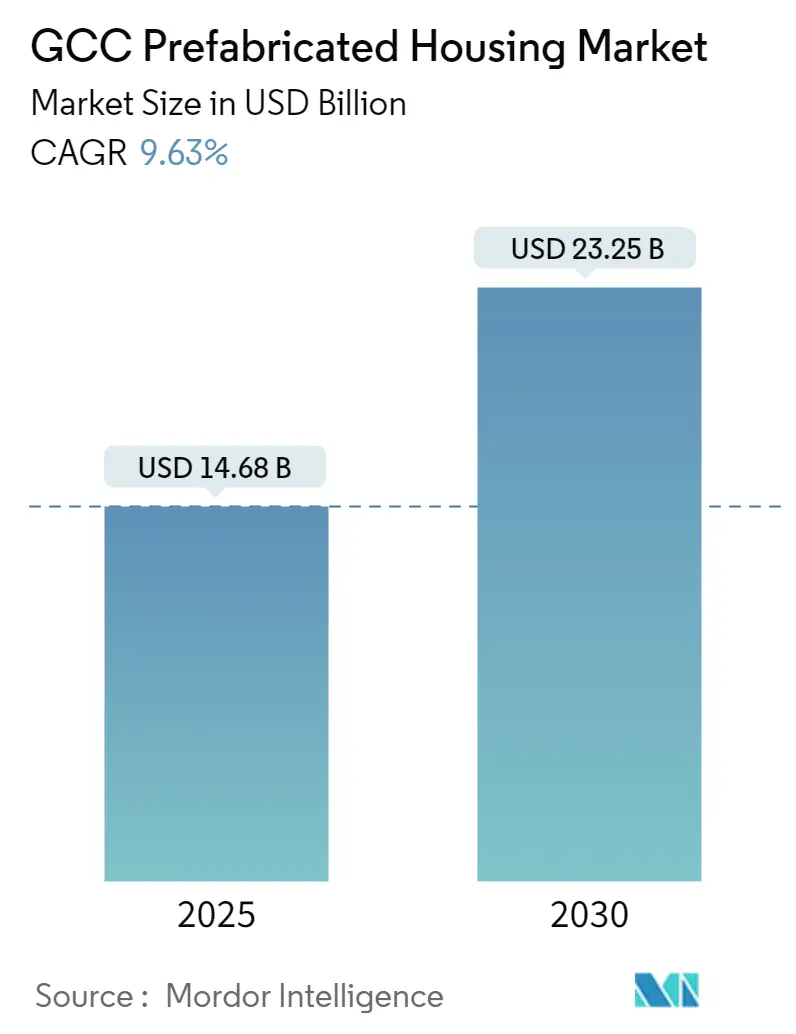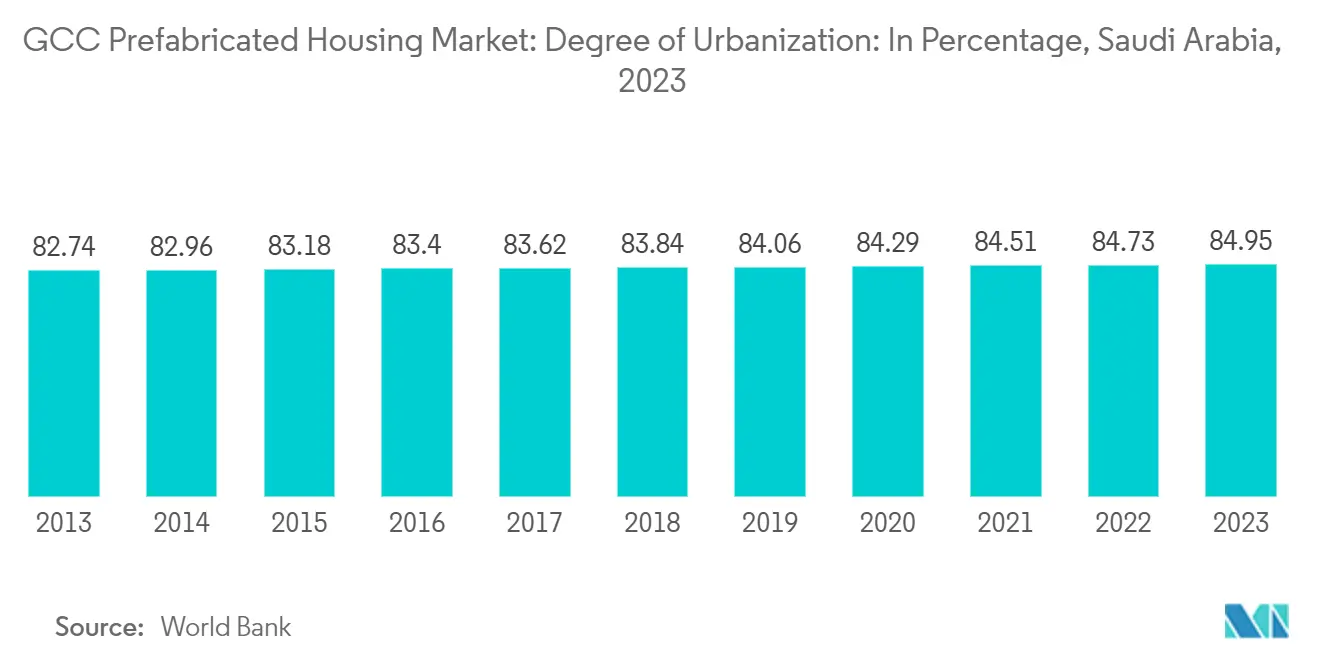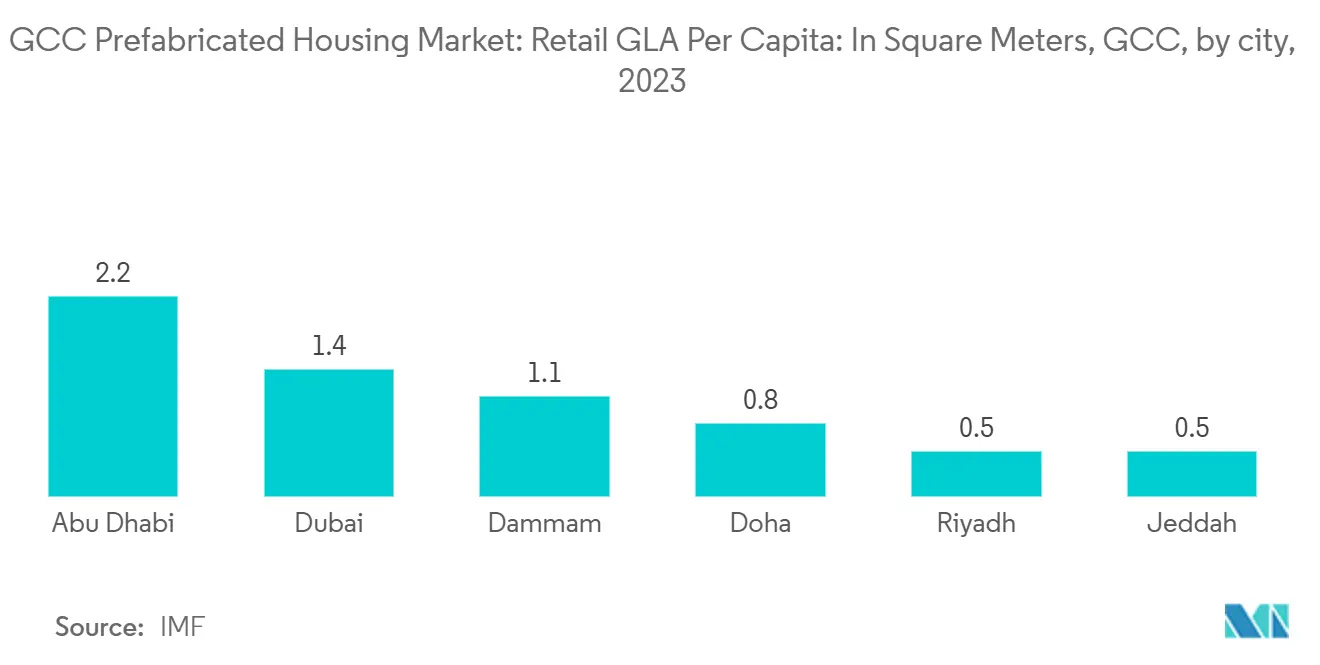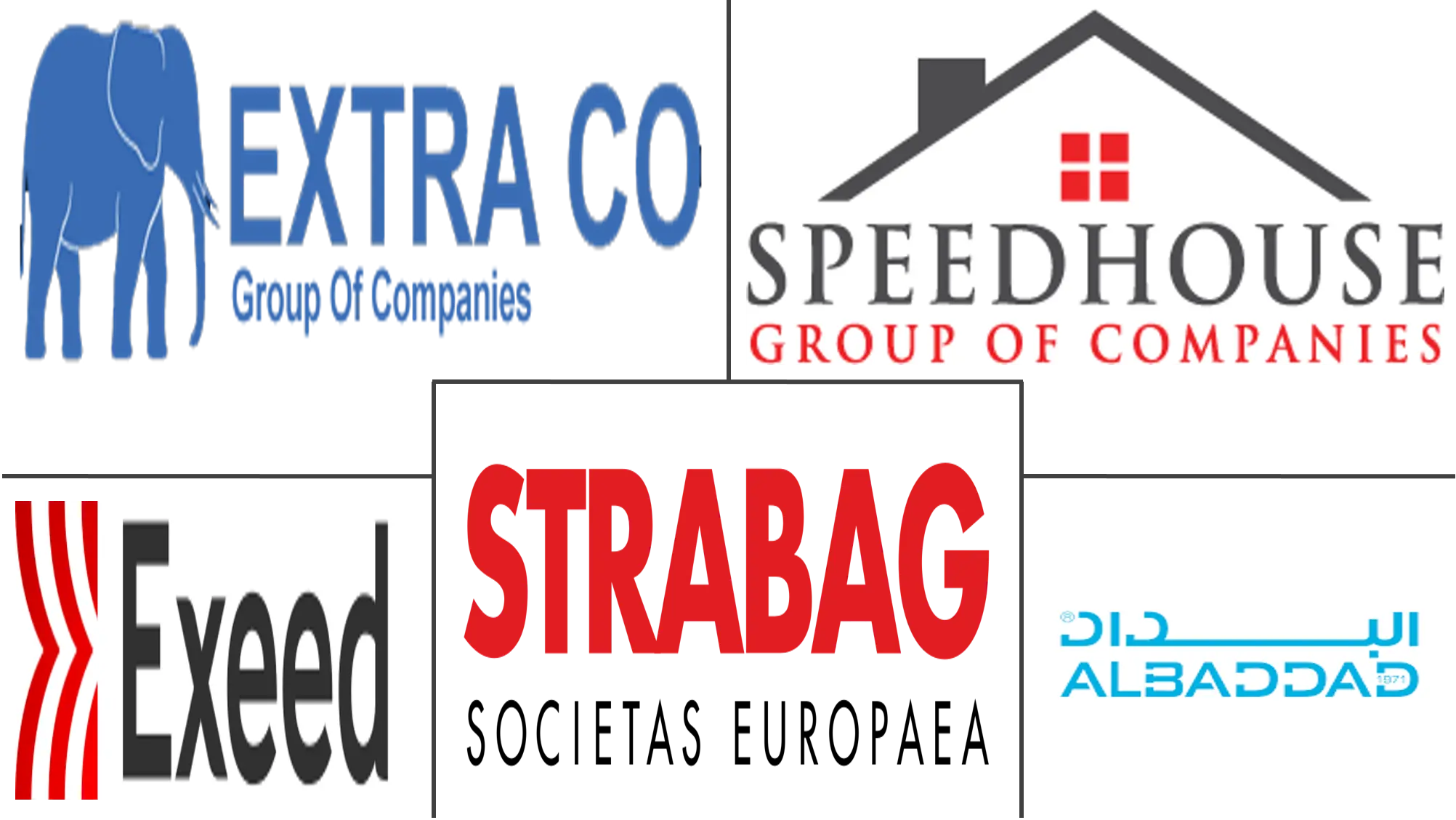
GCC Prefabricated Housing Market Analysis by Mordor Intelligence
The GCC Prefabricated Housing Market size is estimated at USD 14.68 billion in 2025, and is expected to reach USD 23.25 billion by 2030, at a CAGR of 9.63% during the forecast period (2025-2030).
The Gulf Cooperation Council (GCC) region has been reported to experience significant growth in its prefabricated housing market, attributed to rapid urbanization, population growth, and government-driven infrastructure projects. Technological advancements, such as the integration of Building Information Modeling (BIM), robotics, and 3D printing, are said to have further improved the efficiency and attractiveness of prefabricated construction methods in the region.
It has been noted that various government initiatives within the GCC have played a crucial role in the development of the prefabricated housing market. For instance, reports indicate that in the first half of 2024, the UAE Cabinet, under the leadership of His Highness Sheikh Mohammed bin Rashid Al Maktoum, approved the construction of 2,618 housing units valued at over AED2 billion (approximately USD 544.5 million). This initiative is reportedly part of a larger plan to allocate AED32 billion for 34,000 housing units for nationals over the next six years, with the aim of improving citizens' quality of life and addressing housing demands.
Additionally, it has been highlighted that in July 2024, Qatar's Ministry of Social Development and Family announced the opening of nominations for the sixth edition of the GCC Housing Award. This award is said to focus on digital and smart applications in housing projects, emphasizing innovative technologies that enhance economic impact, workflow efficiency, and user-friendliness in housing developments creating a competitive environment and evolve the market landscape.
The adoption of BIM has reportedly become more widespread in the GCC prefabricated housing market. This digital tool is believed to facilitate detailed planning and precise design of prefabricated components, reducing errors and improving collaboration among stakeholders. By enabling virtual simulations, BIM is said to optimize construction processes, resulting in cost savings and better project timelines. Furthermore, reports suggest that 3D printing is being utilized in the GCC to produce customized building components that align with the region's architectural preferences, contributing to faster assembly and reduced material waste.
In conclusion, the GCC prefabricated housing market appears to be on a growth trajectory, supported by government initiatives, technological advancements, and a focus on innovation. These factors are expected to continue driving the market's development and addressing the region's housing needs effectively.
GCC Prefabricated Housing Market Trends and Insights
Rising Demand for Single Family Type in the Region Fuelling the Market Demand
Reports suggest that housing costs in the GCC region are among the highest globally, with cities like Dubai, Abu Dhabi, and Doha witnessing significantly higher rental prices compared to major Indian cities such as Mumbai or Delhi. It has been observed that rental costs vary depending on the location and type of accommodation, including studios, apartments, and villas, which continues to shape housing preferences in the region.
Industry insights indicate that prefabricated homes are transforming the housing market by offering faster construction timelines, with completion possible in 3-6 months compared to the 18-24 months required for traditional homes. This efficiency is attributed to the off-site manufacturing of components in controlled environments, followed by on-site assembly. Analysts have noted that prefabricated homes can reduce costs by up to 20% due to standardized production processes, providing a cost-effective alternative for homeowners.
Market trends highlight that rapid population growth and urbanization in the GCC are driving the demand for affordable housing solutions. Prefabricated homes are increasingly being recognized as a sustainable and economical option to address this demand. Data shows that the GCC population grew from 56.6 million in 2022 to 57.6 million in 2023, with projections indicating that 90% of the population will reside in urban areas by 2050. This urbanization trend is expected to push GCC countries to expand housing unit construction significantly in the coming decades.
In conclusion, the GCC prefabricated housing market is evolving rapidly, driven by the need for cost-effective, sustainable, and timely housing solutions. As urbanization accelerates and housing demand intensifies, prefabricated homes are poised to play a pivotal role in reshaping the region's housing landscape.

Saudi Arabia's Ambitious Projects Fuel GCC's Prefabricated Housing Surge
Saudi Arabia's ambitious development projects and significant investments in prefabricated construction are reportedly driving the growth of the GCC prefabricated housing market. The country's Vision 2030 initiative, aimed at diversifying the economy and addressing housing shortages, is said to be a key factor in shaping the market landscape through large-scale projects.
Reports indicate that the "Jeddah Central" project, launched in March 2024 by Jeddah Central Development Co. (JCDC), a subsidiary of the Public Investment Fund (PIF), includes facilities such as a sports stadium, an opera house, oceanic aquariums, and an industrial museum. These developments are believed to align with Saudi Vision 2030's cultural goals, with the opera house featuring three theaters and a total seating capacity of 2,400. The project is expected to contribute to the demand for prefabricated housing solutions in the region. Similarly, the USD 500 billion Neom megacity in northwestern Saudi Arabia is reportedly accelerating the adoption of modular housing. As of December 2024, Neom has been constructing modular homes to accommodate its workforce, providing temporary housing with amenities like schools, cafes, and recreational facilities, which is seen as a significant boost to the prefabricated housing market.
Additionally, ROSHN, a leading property developer in Saudi Arabia, is said to have launched its first residential community in Makkah in December 2024. This development is considered a milestone in improving living standards in the city while supporting the national development goals outlined in Vision 2030. Such projects are believed to be enhancing the adoption of prefabricated housing across the GCC, contributing to the market's evolution.
In conclusion, Saudi Arabia's large-scale initiatives under Vision 2030 are reportedly playing a pivotal role in transforming the GCC prefabricated housing market. These projects are expected to continue driving demand, reshaping the market landscape, and setting a benchmark for prefabricated construction in the region.

Competitive Landscape
The GCC prefabricated housing market is fragmented. There are several international and domestic companies present in the GCC prefabricated housing market. The market is expected to grow during the forecast period due to the increase in prefabrication building investments and upcoming major projects in the country, among other factors that are driving the market. High capital requirements and rapid technological advancements are important barriers to entry for new participants. Major players are Strabag Dubai LLC, Extra Co. Group of Companies, Albaddad International, Speed House Group of Companies, and Exeed Precast.
For instance, as reported by Bussiness Manual, in April 2024, DMCI Holdings, Inc. has entered the cement business by acquiring Cemex Holdings Philippines, Inc., a move expected to impact the GCC prefabricated housing market. Sources note that Cemex, a global leader in building materials, provides prefabricated solutions tailored to the GCC region, contributing to the market's evolution. The acquisition reportedly involved a share purchase agreement with CEMEX Asia B.V. for 42,140,266 common shares in Cemex Asian South East Corporation (CASEC), which holds an 89.86% equity interest in Cemex Holdings Philippines, Inc.
GCC Prefabricated Housing Industry Leaders
-
Strabag Dubai LLC
-
Albaddad International
-
Speed House Group of Companies
-
Exeed Precast
-
Extra Co. Group of Companies
- *Disclaimer: Major Players sorted in no particular order

Recent Industry Developments
- November 2024: "MODON" and "ALBADDAD Saudi Holding" reportedly signed agreements to establish industrial complexes in Makkah and Al Kharj, with investments exceeding SAR 2 billion (USD 0.53 billion). The Makkah complex, spanning 1.3 million square meters, is expected to invest SAR 1.75 billion (USD 0.47 billion) in specialized industries, utilizing advanced manufacturing technologies, which could influence the GCC prefabricated housing market by enhancing production capabilities.
- September 2024: Cemex announced its acquisition of a majority stake in RC-Baustoffe Berlin GmbH & Co. KG, a recycling company under the Heim Group. This move aligns with Cemex's efforts to expand its circularity business and is anticipated to impact the GCC prefabricated housing market by introducing sustainable practices through the processing of construction, demolition, and excavation materials (CDEM).
GCC Prefabricated Housing Market Report Scope
The GCC prefabricated housing market centers on the production and assembly of pre-built housing units. Commonly known as prefab homes, these structures are predominantly manufactured off-site. Once completed, they are delivered and assembled at their final location. The spectrum of off-site manufactured structures includes modular homes, panelized systems, and precast concrete buildings, all of which are transported for on-site assembly. These solutions are not only cost-effective and time-efficient but also promote sustainability across residential, commercial, and industrial sectors.
The GCC prefabricated housing market is segmented by type (single family and multifamily) and by geography (Saudi Arabia, the United Arab Emirates, Qatar, and the Rest of the GCC). The report offers market size and forecasts for the GCC prefabricated housing market in terms of value (USD) for all the above segments.
| Single Family |
| Multi Family |
| Saudi Arabia |
| United Arab Emirates |
| Qatar |
| Rest of GCC |
| By Type | Single Family |
| Multi Family | |
| By Country | Saudi Arabia |
| United Arab Emirates | |
| Qatar | |
| Rest of GCC |
Key Questions Answered in the Report
How big is the GCC Prefabricated Housing Market?
The GCC Prefabricated Housing Market size is expected to reach USD 14.68 billion in 2025 and grow at a CAGR of 9.63% to reach USD 23.25 billion by 2030.
What is the current GCC Prefabricated Housing Market size?
In 2025, the GCC Prefabricated Housing Market size is expected to reach USD 14.68 billion.
Who are the key players in GCC Prefabricated Housing Market?
Strabag Dubai LLC, Albaddad International, Speed House Group of Companies, Exeed Precast and Extra Co. Group of Companies are the major companies operating in the GCC Prefabricated Housing Market.
What years does this GCC Prefabricated Housing Market cover, and what was the market size in 2024?
In 2024, the GCC Prefabricated Housing Market size was estimated at USD 13.27 billion. The report covers the GCC Prefabricated Housing Market historical market size for years: 2019, 2020, 2021, 2022, 2023 and 2024. The report also forecasts the GCC Prefabricated Housing Market size for years: 2025, 2026, 2027, 2028, 2029 and 2030.
Page last updated on:
GCC Prefabricated Housing Market Report
Statistics for the 2025 GCC Prefabricated Housing market share, size and revenue growth rate, created by Mordor Intelligence™ Industry Reports. GCC Prefabricated Housing analysis includes a market forecast outlook for 2025 to 2030 and historical overview. Get a sample of this industry analysis as a free report PDF download.



